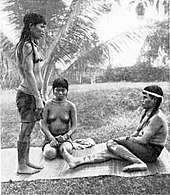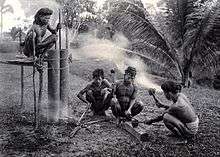Kelabit people
The Kelabit are an indigenous Dayak people of the Sarawak/North Kalimantan highlands of Borneo with a minority in the neighbouring state of Brunei. They have close ties to the Lun Bawang. The elevation there is slightly over 1,200 meters. In the past, because there were few roads (only poorly maintained logging roads, which tended not to be too close to the Bario Highlands) and because the area was largely inaccessible by river because of rapids, the highlands and the Kelabit were relatively untouched by modern western influences. Now, however, there is a relatively permanent road route on which it is possible to reach Bario by car from Miri. The road is marked but driving without a local guide is not advisable, as it takes over 11 hours of driving to reach Bario from Miri through many logging trail junctions and river crossings.
 A group of native Kelabit men, 1912. | |
| Total population | |
|---|---|
| approximately 6,000 (2013) | |
| Regions with significant populations | |
| Borneo: | |
| 1,111 (2000)[1] | |
| 790[2] | |
| no census | |
| Languages | |
| Kelabit language, Malay language (Sarawakian Malay), Indonesian language | |
| Religion | |
| Christianity (predominantly), Animism | |
| Related ethnic groups | |
| Lun Bawang, Sa'ban people | |
With a population of approximately 6,600 people (2013) the Kelabit comprise one of the smallest ethnic groups in Sarawak. Many have migrated to urban areas over the last 20 years and it is estimated that only 1,200 still live in their remote homeland. There, tightly knit communities live in inherited longhouses and practice a generations-old form of agriculture. Hunting and fishing is also practised. Domesticated buffalo are valued highly, seven of which are traditionally required for the dowry for an upper class bride.
Etymology

The name of the people comes from the local word, "na labid"; where the name of people originated from the name of Labid River.[3] Also, other people group names such as Lun Bawang, Lun Dayeh or Southern Muruts are often associated with the Kelabit people. The Kelabit people belong to the Dayak people (it is a large ethnic group of closely related people groups that includes about 200 tribes). With a population of approximately 6,600, the Kelabit people are the smallest people group in the state of Sarawak.
History
During the Second World War the Kelabit, like other natives of Borneo, were co-opted by the Allies into fighting the Japanese. The English academic Tom Harrisson led the Semut I operations (one of four Semut operations in the area), which parachuted into their midst in 1945 to make contact; they were supplied with weapons by the Australian military and played an essential role in the liberation of Borneo.[4]
Religion
After the Second World War the Kelabit people received visits from Christian missionaries of the Borneo Evangelical Mission. The Kelabit are now predominantly Christian. Prior to conversion they had a custom of erecting megaliths and digging ditches in honour of notable individuals. As the Kelabit people began to Christianize in the early 20th century, so did the process of ethnic consolidation were also intensified.[5]
Language
The Kelabit people uses Latin script that were introduced to the island by the colonialist from Europe. The Kelabit language belongs to the North Bornean branch of the Western Malayo-Polynesian languages.[6] The Kelabit language is used in one of the most remote areas of the Borneo island in the Bario highlands of Kalimantan and northern Sarawak. There are several dialects in the Kelabitic languages such as Lepu Potng, Padas, Trusan and so on.
Culture
_(14598282467).jpg)
Family
There is a strict order (rule) of inheritance, which includes the need for one person to organize expensive commemorative celebrations (perhaps, a wake) for people who inherit from them. The conflict between older brothers and sisters can be particularly noticeable in connection with these circumstances. In any case, the Kelabit family is a cooperating unit.[7]
Adults are called lun merar, which literally means "big people". In order to attain adulthood, one must have three things:-[8]
- A spouse, with whom one would grow rice together
- Children
- Rice, with which one would be able to feed their children and grandchildren
In rural communities there is a division of castes namely, the nobility, the ordinary community members and the descendants of those who were in slavery. The leader always comes from the nobility. He must have things that are regarded as special prestige among the Kelabit people. These are ancient items of Chinese origin such as, porcelain vases, beads or gongs, as well as items that are made from pearls.
Settlements
Kelabit villages usually include only one longhouse, in which all the inhabitants of the community would live in. A longhouse can stretch as long as 75 meters in length. Such house does not have partitions that divides into rooms.[5]
Clothing

In traditional society, men wear traditional loincloths, and the women would wear skirt made of Tapa cloth (material from the inside of the tree bark). Some would prefer Westernized clothing. The custom of tattooing and dulling of teeth have also become less prevalent.[5]
Cuisine
Rice, for the Kelabit people, symbolizes the true human food. Kelabit people mainly eat rice, and also additionally meat, fruits, vegetables, corn and sugar cane.[9] Traditional Kelabit cuisine are such as:-[10]
- Nubak Layak, mashed rice wrapped in Isip leaf.
- Manuk Pansuh / Pansoh, seasoned chicken cooked in bamboo.
- Udung Ubih, tapioca leaves stir-fried with lemongrass.
- A'beng, de-boned fish.
- Pa’uh Ab’pa, fish cooked in brinjal, cucumber and black fungus soup.
- Labo Senutuq, shredded beef stir-fried with bamboo shoots and Kantan flower salad.
Festivals
- Bario Food and Culture Festival (Irau Nukenen Bario)
2019 dates are 25th, 26th, 27 July
Traditional activities
Pottery, blacksmithing and wood carving are all traditional crafts of Kelabit people. The form of the stone adze (chopping tools) of the Kelabit differs noticeably from the types previously recorded in Southeast Asia; where its 'quadrangular' is from Malaysia, and there is no 'round ax'.[11] Also traditional occupation of the Kelabit people includes needle-working. There are 69 items with pearls (necklaces, hats and belts) decorations. Pearl jewelry is a sign of prestige, just like Chinese porcelain vases. Necklaces are worn by both men and women, while headdresses are exclusively for women.[12] Kelabit people are interested in precious stones. Earlier before they became Christians, Kelabit people had stone amulets. Agriculture is a traditional occupation of the Kelabit people.
Livelihood and economy
The traditional occupation of Kelabit people is agriculture. The main cultivar is rice. They distinguish between wet paddy field and dried paddy field. In the north of the Bario Highlands, there are only wet paddy field areas. In other parts of the Highlands, dried paddy field areas have also been made, as well as other crops that have also been planted in these paddy field areas. The Kelabit people are also cultivators of maize, tapioca, pineapple, pumpkin, cucumber, beans, coffee, lemon grass, taro and various fruit like passion fruit and strawberry. Livestock development is limited. Meat is a special problem, as traditionally the Kelabit people used it only for sacrifices, and even today almost no animals are slaughtered for daily consumption (since, at present, there are still many Kelabit people who are adherents of traditional beliefs).[13] Subsequently, they began to raise animals for dairy products and meat. The forest is the main source of wild fruits and vegetables. Forest gathering, hunting and fishing are common.[14] Kelabit people engages in salt extraction; which plays a significant role in their economy. With salt, they would exchange from other people for their own necessities.
Notable people
- Alena Murang - Kuching-born artist, dancer, musician, teacher, activist, social entrepreneur and cultural ambassador. She is of Kelabit-English-Italian descent.[15][16]
- Hannah Tan - Penang-born singer-songwriter, model and actress. She is of Chinese-Kelabit descent.[17]
- Idris Jala[18] - former Malaysian minister.[19]
- Kuda Ditta (1937-2003) - Former Olympian and policeman.[20]
- Ngalinuh Bala - Former policeman and recipient of Grand Knight of Valour (Darjah Kebesaran Seri Pahlawan Gagah Perkasa), for his gallantry during the Communist insurgent attack.[20]
References
- Raymond G. Gordon Jr., ed. (2005). Ethnologue: Languages of the World, Fifteenth edition. SIL International. ISBN 1-55671-159-X.
- "Kelabit in Indonesia". Joshua Project. Retrieved 7 January 2015.
- "Келабиты". Etnolog. Retrieved 21 February 2018.
- Cecilia Sman (14 August 2016). "Teripun a reminder of Kelabits' roots". The Borneo Post. Retrieved 5 November 2016.
- Тишков В.А., ed. (1999). Народы и религии мира. Энциклопедия. М.: Большая Российская энциклопедия. p. 335.
- "William J. Frawley". International Encyclopedia of Linguistics: AAVE - Esperanto, Volume 1. Oxford University Press. 2003. p. 112. ISBN 01-951-3977-1.
- Tom Harrison, ed. (1945–1948). Human Studies in Central Borneo. Man, v50 (19500201): 19-20. p. 19. ISSN 0025-1496.CS1 maint: date format (link)
- Monica Janowski (October 1996). "The Kelabit attitude to the Penan: Forever children". La Ricerca Folklorica. p. 56. Retrieved 1 March 2018.
- Monica Janowski (October 1996). "The Kelabit attitude to the Penan: Forever children". La Ricerca Folklorica. pp. 55–56. Retrieved 1 March 2018.
- Dave Avran (15 November 2012). "Tribal Scoops: Traditional Kelabit offering". Free Malaysia Today. Archived from the original on 14 April 2014. Retrieved 5 November 2016.
- Tom Harrison, ed. (1945–1948). Human Studies in Central Borneo. Man, v50 (19500201): 19-20. p. 20. ISSN 0025-1496.CS1 maint: date format (link)
- Monica Janowski & Chiara Ingrao (October 1996). "Perle, prestigio e vita tra i Kelabit di Sarawak". La Ricerca Folklorica: 49. doi:10.2307/1480174. JSTOR 1480174. Cite journal requires
|journal=(help) - Monica Janowski (October 1996). "The Kelabit attitude to the Penan: Forever children". La Ricerca Folklorica. p. 55. Retrieved 1 March 2018.
- "КЕЛАБИТЫ". Go Turist. 18 January 2016. Retrieved 3 March 2018.
- Mariam Azmi (17 May 2019). "Alena Murang: Break Taboo For The Sape Tune To Continue". Awani Review. Retrieved 6 December 2019.
- Sukhbir Cheema (13 June 2019). "Armed with the Sape', Alena Murang reveals to us why preserving Sarawak's heritage through music is important". Mashable South-East Asia. Retrieved 6 December 2019.
- Aref Omar (27 July 2017). "Hannah takes on Malay-speaking role". New Straits Times. Retrieved 6 December 2019.
- "The Journey Continues". IdrisJala.My. Archived from the original on 1 October 2015. Retrieved 30 September 2015.
- "Idris Jala no more a minister, remains CEO of Pemandu". The Malaysian Insider. Archived from the original on 29 September 2015. Retrieved 30 September 2015.
- Philip Kiew (26 September 2018). "Kelabits salute, honour living SP hero". The Borneo Post. Retrieved 6 December 2019.
External links
- The eBario and Bario Infopages
- A Brief Profile: The Kelabit of the Kelabit Highlands
- The Bario Kelabit Language Wiki
| Wikimedia Commons has media related to Kelabit people. |
